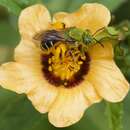en
names in breadcrumbs


Eickwort and Eickwort (1969) describe the biology of this species near Turrialba, Costa Rica. Agapostemon nasutus is a bright green and black (female), and bright green and black and yellow (male) bee that occurs from Texas to Venezuela, Colombia, and southward west of the Andes to Peru. The species is apparently active year-round at the authors’ study site.
This species is communal, nesting in groups of 1-15 females, in which each female provisions her own brood cells and reproduces. Females may enter burrows dug by other females and construct and provision new cells there, thus females nesting together are not necessarily closely related. During the time of the study (July and August), 68% of emerging new offspring were males.
This bee's nest architecture is described by Sakagami and Michener (1962): Nest architecture is Type II: Lateral burrows branch off from the main burrow. These lateral burrows contain cells constructed in series (1-6 cells), such that each blocks the one previously constructed. Banks are the only known substrate used for nesting. Nests may contain more than one entrance, presumably due to multiple females constructing burrows, and may reach 62 cm deep.